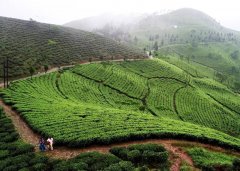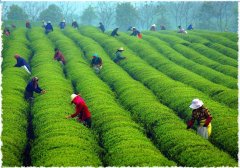Where can I buy good black tea Darjeeling black tea in India will get angry if you drink it?
In Darjeeling, the first harvest of red beans began in February. The first batch of red beans are rich in water, so they wither longer and ferment less. That's why the first blush is very light, floral and green in flavor and very soft in flavor. From April to the end of May, Darjeeling will usher in the rainy season. After the rainy season ends, the "second red" season known as musky grapes will usher in. What causes the second wave of musky grape smell?
The real reason has long been unknown. This is due to the tiny green fly being a contributor to the production of musky grape flavor. It has exactly the same mechanism as Taiwan's oriental beauty.
When the rainy season ends, a large number of green flies rise from the ground and start sucking the sap of the tea leaves. Once the tea leaves are absorbed, it turns yellow and begins to produce certain antibiotics. In scientific terms, this substance is called a phytoalexins. It is this substance that gives tea a very attractive musky grape flavor.
There is also an insect that adds flavor to musky grapes called thrips. Usually the insect hides behind leaves, inside buds or flowers.
But as soon as the season approaches, it spreads throughout the tea garden and starts sucking the sap out of the leaves. Leaves attacked by this insect also produce a musky grape smell. As far as we know, only these two insects can produce the smell of musky grapes. Other insects are basically classified as pests.
According to a tea plantation manager, he went to a tea plantation when he was very young. Tea plantations were heavily infested by green flies, and all tea leaves turned yellow. As he passed that area, he could smell a rich fruity aroma.

During September-October, insect populations decrease and green flies have less impact on tea leaves. Most of the flavors consist of a very Darjeeling sweetness. Tea harvested in November to December is also known as autumn tea, but the characteristics of the tea are very different from autumn tea harvested earlier.
In November and December, tea leaves begin to produce very soft buds, like early spring tea. In late autumn to winter, less rain, cold weather, tea by environmental pressure, growth rate is very slow. Therefore, this substance is concentrated in tea leaves, and the final tea becomes very sweet and fragrant, which is similar to the characteristics of Taiwanese winter tea.
There are several different cultivars in Darjeeling. Assam varieties grow in low-lying tea plantations. Assam varieties have intense astringency and less sweetness. Mainly used for tea bag and low-end tea production. Tea plantations located above 1000 meters above sea level are planted with hybrid varieties between China and Assam.
It is called a clonal variety. There are many Chinese varieties in tea gardens above 1000 meters above sea level, and tea gardens above 1500 meters above sea level may be Chinese varieties. Chinese varieties can only grow in cold weather. It gives a very sweet taste and subtle aroma, especially in autumn.
Clonal varieties provide a very strong aroma, but weak in flavor and taste. It has a bit of astringency, not a strong taste. Because of their characteristics, clones are sometimes used in blends to enhance aroma.
Important Notice :
前街咖啡 FrontStreet Coffee has moved to new addredd:
FrontStreet Coffee Address: 315,Donghua East Road,GuangZhou
Tel:020 38364473
- Prev

Is Darjeeling black tea produced in the Himalayas? where is Darjeeling black tea the most authentic? how to buy it?
Darjeeling Tea Garden was once developed in England. Because of the high altitude, Chinese varieties can survive in Darjeeling. Chinese varieties need cold weather, which other British colonies cannot adapt to. This is why the tea from the Darjeeling tea garden at a higher altitude is very good. The British introduce a very traditional and rational approach. They developed a very effective management system.
- Next

Which brands of the top 10 famous Keemun Black Tea in the black tea list are authentic Keemun Black Tea and where to buy them?
Keemun Black Tea is a famous black tea in Chinese history. In the Qing Dynasty, Qimen Black Tea County came from (Qimen County, Qimen Xi'an) in Anhui and its surrounding areas (Bilin Sheng, Anhui Province). It is said that Qimen was inspired by the famous race of black tea Zhengshan in Fujian. In the past, Qimen's main exports were highly appreciated by overseas people, especially the United Kingdom and the United States. The tea is delicate and sweet.
Related
- A complete list of coffee bean names and their meanings! What is Yejia Shefi coffee? Where is Mantelin coffee?
- What grade does Arida Manor Kaduai coffee beans belong to? What treatment is Arida ASD slow anaerobic sun exposure?
- The milk tea cup becomes smaller?! Overlord Tea Girl launches a new "Return to Yunnan" series
- Accused of selling counterfeit and high-priced coffee beans! Well-known boutique coffee brand "Oukelao" bowed and apologized!
- How to make espresso dumplings? Can I eat coffee and glutinous rice balls together?
- Save the unformed and stagnant powder cakes in one second! What is the problem with stagnant water in the powder bowl of the espresso machine?
- What does hand-brewed coffee stop mean? Why is it not recommended to make coffee by hand?
- Is it normal to smell like coffee? Why does coffee smell like alcohol? What's wrong with the strong smell of cold extract ice dripping ice brewed coffee?
- How to solve the problem that hand-brewed coffee extraction takes too long? Why is the water flowing so slowly when making coffee?
- The main points of making Australian white coffee, the proportion details, how does Australian white properly foam and blend the flowers?

